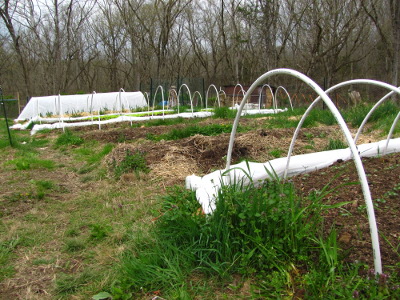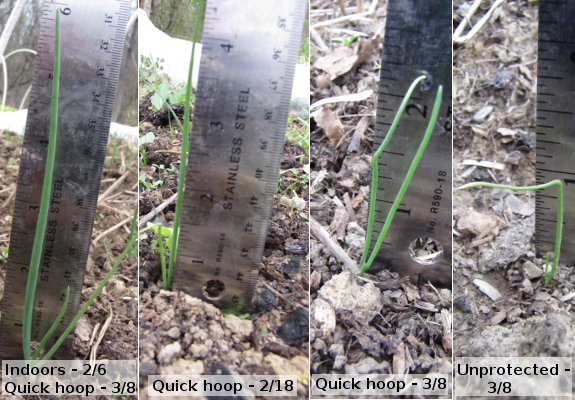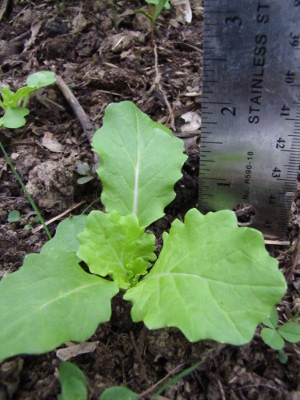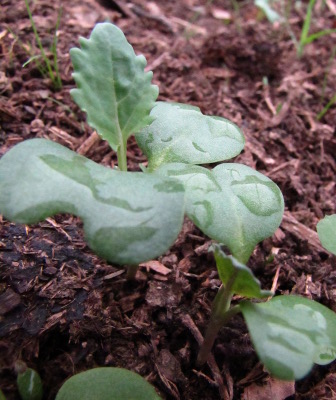
Under the quick hoops
 I
took the fabric off all of the quick
hoops except the tomato
bed
Saturday because the heat was starting to make the lettuce turn a bit
bitter (and I wanted the plants to capture every raindrop from the
weekend's thunderstorms.) I'll probably re-cover the beds tonight
and leave them protected for a while since the weather is supposed to
return to 30s to 60s rather than the recent 50s to 80s.
I
took the fabric off all of the quick
hoops except the tomato
bed
Saturday because the heat was starting to make the lettuce turn a bit
bitter (and I wanted the plants to capture every raindrop from the
weekend's thunderstorms.) I'll probably re-cover the beds tonight
and leave them protected for a while since the weather is supposed to
return to 30s to 60s rather than the recent 50s to 80s.

 I
was intrigued to see the differences between onion seedlings planted
at various times, and places: inside, under quick hoops, and
unprotected outside. As you might expect, the onions started
earliest inside then transplanted under the row covers are tallest,
followed by the earliest plants direct-seeded into quick hoops, then by
later plants direct-seeded into quick hoops. The onions seeded
directly into unprotected ground once the soil temperature reached 35
degrees are smallest, but they've all germinated in good
numbers and I suspect the head start given by the row covers won't make
much difference in the long run. I'll let you know if I can still
see effects of
the various planting schedules at harvest time, but since onions aren't
a crop I need to rush to the table, I may plan to use the quick hoops
for something else next spring.
I
was intrigued to see the differences between onion seedlings planted
at various times, and places: inside, under quick hoops, and
unprotected outside. As you might expect, the onions started
earliest inside then transplanted under the row covers are tallest,
followed by the earliest plants direct-seeded into quick hoops, then by
later plants direct-seeded into quick hoops. The onions seeded
directly into unprotected ground once the soil temperature reached 35
degrees are smallest, but they've all germinated in good
numbers and I suspect the head start given by the row covers won't make
much difference in the long run. I'll let you know if I can still
see effects of
the various planting schedules at harvest time, but since onions aren't
a crop I need to rush to the table, I may plan to use the quick hoops
for something else next spring.
Something
like greens, maybe. Asian greens (above) and volunteer mustard
are nearly big enough to eat, and the swiss chard started in a quick
hoop already has two true leaves. We've had a couple of meals of
 overwintered kale and mustard greens, but with only four plants
surviving, we're ready for a big mess of fresh greens. Maybe in a
week or so?
overwintered kale and mustard greens, but with only four plants
surviving, we're ready for a big mess of fresh greens. Maybe in a
week or so?
Last
year at this time, we'd already planted out our broccoli and cabbages,
but the seedlings are still a bit small for transplanting. It's
tough to tell whether a cold frame would have made these crucifers come
up sooner than the quick hoops did --- the asparagus was earlier last
year
too, which makes me think that the soil just took a bit
longer to warm up this spring than last.
The mule garden is
starting to feel full and vibrant again with all of this new
growth. Time to mow the aisles and dream of big harvests!
Want more in-depth information? Browse through our books.
Or explore more posts by date or by subject.
About us: Anna Hess and Mark Hamilton spent over a decade living self-sufficiently in the mountains of Virginia before moving north to start over from scratch in the foothills of Ohio. They've experimented with permaculture, no-till gardening, trailersteading, home-based microbusinesses and much more, writing about their adventures in both blogs and books.
Want to be notified when new comments are posted on this page? Click on the RSS button after you add a comment to subscribe to the comment feed, or simply check the box beside "email replies to me" while writing your comment.
